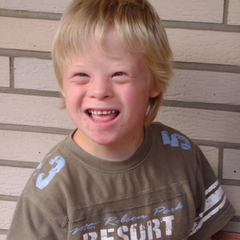
Down Syndrome Awareness Month - October
October is Down Syndrome Awareness Month, and we wanted to share some information about the condition and share a little about the people who have it.
What is Down’s syndrome?
It is a congenital disorder resulting from an abnormality in chromosome 21. Specifically, there is extra genetic material on the chromosome, which causes delays in cognitive development, short stature and characteristic facial features. The physical and cognitive delays can vary widely from person to person, with some requiring full time care whilst others require very little attention at all.

Physical characteristics
Physical characteristics vary but there are common physical traits amongst people with Down’s syndrome:
- Underdeveloped muscle tone
- Slanted eyes
- Smaller than usual mouth
- Below-average weight and length at birth
- Flat back of head
- Deep crease across palm
- Very flexible joints
- Small, wide hands
Post-natal diagnosis is often based on the above characteristics, although pre-natal testing can also be carried out from 15-20 weeks. Testing during pregnancy however, is not always accurate and testing specifically for the condition is a controversial issue because it typically doesn’t affect the child’s quality of life.
Statistics
- Every year, around 775 babies are born with Down ’s syndrome in England and Wales.
- 60,000 people have it in the UK, that’s 1 in every 1000 babies born.
- In the USA, 400,000 people have Down’s syndrome.
- 80% of children with Down’s syndrome are born to mother’s under 35, but the proportional rate is higher for mothers over 35
Prospects for children with Down’s syndrome
Children with the condition can live full and joyous lives, with many children attending mainstream schools, achieving GCSEs, partaking in a full range of activates and generally living normal lives. Many can and do work in their communities, whilst others require a more structured environment.
It is important to note that children with it don’t “suffer”, they simply have a mild to moderate developmental delay.

There are medical conditions associated with Down ’s syndrome, including Leukaemia, Alzheimer’s and thyroid and intestinal problems. It is unlikely that any individual will have all of these problems together, and some don’t have any at all. Life span is typically 50-60, with some living into their 70s.
Each child is different – some will be suitable for mainstream education whilst other won’t be. Some will require residential schooling to get the help they need whilst others can live at home with their parents. There is no set criteria.
Bust the myths
There is a huge amount of misunderstanding about the condition, and about the quality of life that children and parents will have. There are many myths surrounding Down syndrome people, some of which you can read here. When it comes to happiness and quality of life, children with Down’s syndrome are no different to any other child.
Resources
http://www.nhs.uk/Conditions/Downs-syndrome/Pages/Treatment.aspx
http://www.downs-syndrome.org.uk/for-families-and-carers/education/
http://www.nhs.uk/Livewell/Childrenwithalearningdisability/Pages/Education.aspx
http://www.friendshipcircle.org/blog/2013/03/20/42-top-down-syndrome-resources-you-should-know-about/

